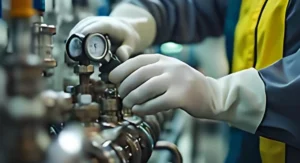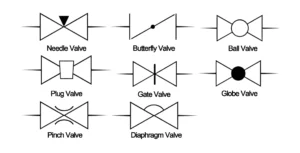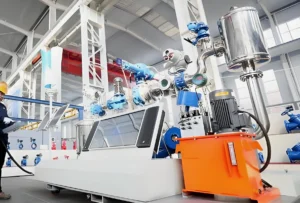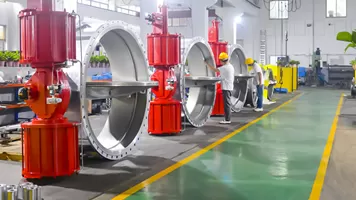Butterfly Valve Description
Butterfly valve is a simple structure, small size, light weight, easy to operate valves, in many industrial fields such as petrochemical, electric power, water supply and drainage has a wide range of applications. It rotates the valve flap to control the fluid on and off or flow regulation, and its performance depends largely on the process control and the level of technology used in the production process.
Translated with DeepL.com (free version)
Butterfly valve production process
Raw material preparation
The main raw materials of butterfly valve include valve body, valve flap, valve shaft, sealing materials and so on. The valve body usually adopts cast iron, cast steel, stainless steel and other metal materials, which need to have good strength, corrosion resistance and processability. Raw materials should be strictly inspected when purchasing their quality documents to ensure that their composition and performance meet the design requirements. For metal materials, pre-treatment, such as rust removal and cleaning, may also be required to ensure the quality of subsequent processing.
Valve Body Processing
Casting or forging
According to the material and design requirements of the valve body, choose the appropriate casting or forging process. Casting process can produce complex shape of the valve body, but need to pay attention to the control of casting defects, such as porosity, shrinkage, etc.. Forged valve body has better mechanical properties, but the cost is relatively high and the shape is relatively limited.
Mechanical processing
Turning: the valve body of the two end faces, bore, etc. for turning to ensure its dimensional accuracy and flatness. For example, when turning the inner hole, it is necessary to control the hole diameter tolerance and cylindricity to provide a good foundation for the installation of the valve seat.
Drilling and tapping: Drill holes on the valve body for installing bolts, stuffing box and other parts, and carry out tapping operation to ensure the accuracy and strength of the threads.
Milling: Milling the connection flange surface of the valve body to ensure the perpendicularity of the flange surface and the axis of the valve body as well as the flatness of the flange surface, so as to reliably connect with the pipeline system.
Valve Flap Processing
Unloading and molding
Flap materials are usually selected according to the working conditions of butterfly valves, such as stainless steel plate or other alloy materials. Through the cutting equipment, the raw material will be undercut into a suitable shape and size, and then stamping, forging or machining will be used to make it molded into the shape of the butterfly valve flap, for example, the stamping process can be used to quickly mold the valve flap blank with a certain curvature and dimensional accuracy.
Finishing
After molding the valve flap for finishing, including turning the outer circle, milling the sealing surface and other operations. The sealing surface of the valve flap needs to achieve high surface roughness requirements to ensure good sealing performance. Usually grinding or milling process to achieve, and to strictly control the flatness of the sealing surface and the perpendicularity of the mounting holes with the valve shaft.
Valve shaft machining
Selection of material and materialization
The valve shaft is generally made of high quality alloy steel with high strength and toughness. According to the design size for the material, to ensure that the length and diameter meet the requirements.
Processing technology
Turning: The outer circle of the valve shaft is turned to ensure its diameter tolerance and cylindricity, and at the same time, the shoulders and journals are processed to match with the valve flaps and bearings.
Grinding: In order to improve the surface hardness and finish of the valve shaft, grinding is usually carried out after turning, especially for the parts in contact with the seals, so as to reduce friction and wear and prolong the service life of the valve shaft.
Manufacture of seals
Butterfly valve seals are commonly used rubber, PTFE and other materials. For rubber seals, rubber mixing, vulcanization molding and other processes. First of all, the rubber raw materials and various additives for mixing, so that it reaches the required performance, and then according to the shape of the seals to make molds, will be mixed into the mold for vulcanization molding, vulcanization process should be strictly control the temperature, pressure and time and other parameters in order to ensure that the dimensional accuracy of the seals and sealing performance. PTFE seals can be manufactured by machining or molding, etc. During the process, care should be taken to avoid deformation and damage to the material.
mounting
Assembly of valve and valve shaft
The processed valve flap is assembled with the valve shaft, usually by means of interference fit or key connection to ensure that the valve flap can rotate stably on the valve shaft without loosening. Apply appropriate amount of grease to reduce friction, and ensure that the relative position of the sealing surface of the valve and the valve body is correct.
Valve seat installation
Install the sealing seat to the valve body, and use different installation methods according to the type of seat, such as press-in type, welded type or threaded connection type. For the press-in seat, use special tools to press it evenly into the valve body sealing groove, to ensure that the seat and the valve body sealing surface of the close fit; welded seat should be strictly control the welding process parameters, to prevent welding deformation affecting the sealing performance; threaded seat to ensure that the threaded connection of the tightness and sealing.
Other parts assembly
Install packing box, packing gland, bolts and nuts, etc. The packing box is filled with suitable packing, such as graphite packing, etc., and the sealing at the valve stem is realized through the compression of the packing gland. In the assembly process, attention should be paid to the installation sequence of each part and the control of preload to ensure the integrity and sealing of the overall structure of the butterfly valve.
Testing and Commissioning
Appearance inspection
Check the appearance of the butterfly valve whether there are scratches, cracks, sand holes and other defects, whether the connection parts are firm, whether the nameplate marking is clear and complete.
Dimension Inspection
Use gauges to test the key dimensions of the butterfly valve, such as the caliber of the valve body, the diameter of the valve flap, the length of the valve shaft, etc., to ensure that the dimensions are in accordance with the requirements of the design drawings.
Sealing performance test
Adopt hydraulic test or pneumatic test to test the sealing performance of butterfly valve. The test will be installed on the test bench, close the valve, apply the specified pressure of the test medium on one side, and observe whether there is leakage on the other side. According to different standards and requirements, the test pressure and holding time are different, such as for general industrial butterfly valves, the hydrostatic test pressure is usually 1.5 times the working pressure, and the holding time is not less than 5 minutes.
Torque Test
Test the torque required to open and close the butterfly valve to ensure that it is within the design range. Through the special torque test equipment, measure the torque value of the valve spindle in the process of rotation, for the torque is too large or too small, we should analyze the reasons and make adjustments, which may be related to the sealing friction is too large, the valve spindle and the bearings are too tightly fitted and other problems.
Flexibility test
Operate the butterfly valve manually or electrically to check whether the opening and closing process is flexible and smooth, and whether there is any stagnation phenomenon. Observe whether the rotation angle of the valve flap meets the requirements. For electric butterfly valve, also test the function of its electrical control part, such as remote control, limit switch action.
Butterfly valve key technology
Sealing technology
Soft Seal Technology
Soft seal butterfly valve mainly relies on elastic materials such as rubber or plastic as sealing parts. The sealing principle is to fill the small gap between the sealing surfaces through the elastic deformation of the sealing parts by squeezing between the valve flap and the valve seat, thus realizing the sealing. The key to soft sealing technology lies in the selection of sealing materials and the processing accuracy of the sealing surface. Sealing materials should have good temperature resistance, corrosion resistance, elasticity and wear resistance to adapt to different working conditions. The machining accuracy of the sealing surface directly affects the sealing effect, and the surface roughness and flatness should be strictly controlled to ensure that the seals can be uniformly pressurized to achieve good sealing performance.
Hard seal technology
Hard seal butterfly valve adopts metal sealing surface, such as stainless steel and stainless steel, hard alloy and hard alloy and other pairs. Its sealing mainly relies on the high-precision processing of the sealing surface and appropriate preload. The sealing surface processing of hard seal butterfly valve requires extremely high flatness and finish, and usually adopts grinding, honing and other precision machining processes. In the process of use, by adjusting the connection structure between the valve seat and the valve body or using elastic elements to provide the appropriate preload, so that the sealing surface closely fit, while also taking into account the metal sealing surface in high temperature, high pressure and other conditions of thermal expansion and deformation factors, in order to ensure long-term stability of the sealing performance.
Seat fixing technology
Press-in seat fixing
Press-in seat is to press the seat directly into the sealing groove of the valve body. The advantage of this method is simple structure, easy to install, but the valve seat and the valve body sealing groove of the size of the high precision requirements. In order to ensure the reliability of the seat fixing, the size and direction of the pressing force should be controlled in the process of pressing in to prevent the seat from tilting or deformation. At the same time, appropriate sealant or O-ring can be used between the seat and the valve body to enhance the sealing effect and prevent leakage of media from between the seat and the valve body.
Welded seat fixed
Welded seat is suitable for butterfly valves under high temperature, high pressure and other severe working conditions. The valve seat and the valve body are connected as a whole by welding, which has high connection strength and reliability. However, the welding process is prone to welding deformation, which affects the accuracy of the sealing surface of the valve seat. Therefore, a reasonable welding process should be used in welding, such as selecting the appropriate welding method (such as argon arc welding), controlling the welding current, voltage and welding speed and other parameters, and carrying out appropriate heat treatment after welding to eliminate the welding stress, to ensure the flatness of the sealing surface of the valve seat and the sealing performance.
Threaded seat fixing
The threaded seat is screwed into the threaded hole of the valve body. This way is convenient for the disassembly and replacement of the valve seat, but the sealing and fastening of the threaded connection is the key issue. The specification and precision of the threads should be reasonably selected during design, appropriate thread sealant should be used during installation, and the seat should be tightened according to the specified torque to prevent medium leakage and loosening of the seat.
Torque control technology
Matching design of valve shaft and bearing
Reasonably design the fit clearance and surface roughness of the valve shaft and bearing to reduce the friction resistance when the valve shaft rotates. Adopt high-precision bearings and select suitable bearing types, such as deep groove ball bearings and tapered roller bearings, according to the working pressure and caliber of the butterfly valve to ensure that the valve shaft can rotate flexibly and reduce the opening and closing torque.
Seal friction control
The friction between the seal and the valve flap and seat is an important factor affecting the torque of the butterfly valve. For soft seal butterfly valves, the friction coefficient between seals and sealing surfaces is reduced by optimizing the formulation of sealing materials and sealing structure design. For example, rubber materials with good self-lubricating performance are used or friction reducing coatings are applied to the sealing surface. For hard seal butterfly valve, under the premise of guaranteeing sealing performance, reduce the preload of sealing surface appropriately, and adopt good lubrication measures, such as injecting grease or lubricating oil between sealing surfaces, to reduce the friction and abrasion between metal sealing surfaces, so as to control the operating torque of butterfly valve.
Torque matching of electric actuator
For electric butterfly valve, the torque output of the electric actuator should be matched with the opening and closing torque of the butterfly valve. When designing and selecting, the required torque value should be calculated accurately according to the specification of butterfly valve, working pressure, medium characteristics and other factors, and the electric actuator with suitable torque output range should be selected. At the same time, the electric actuator should have a torque protection function, when the butterfly valve in the operation of the process of stagnation and other abnormal conditions resulting in excessive torque, can automatically stop the operation and send an alarm signal to prevent the electric actuator and the butterfly valve damage.







